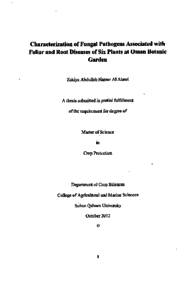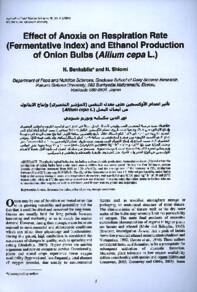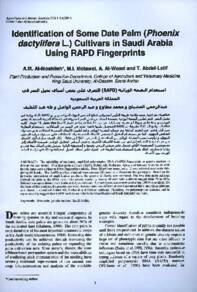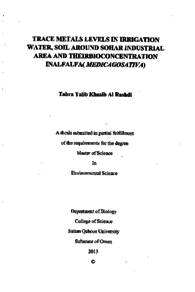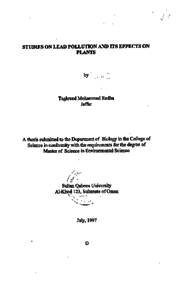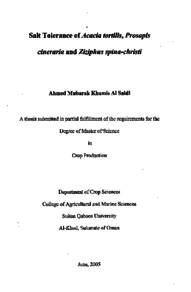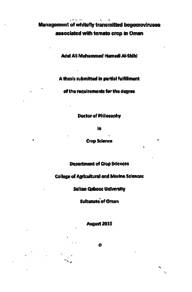وثيقة
Characterization of fungal pathogens associated with foliar and root diseases of six plants at Oman Botanic Garden.
الناشر
Sultan Qaboos University
ميلادي
2012
اللغة
الأنجليزية
الملخص الإنجليزي
Oman Botanic Garden (OBG) was established in 2006 to conserve, display and research the plants and ethnobotany of Oman. However, over one thousand seedlings and plants were killed over the previous years due to diseases of unknown etiology. This study was conducted to characterize the main fungal pathogens associated with foliar and root diseases of six native plants at OBG. A survey over 2008 to 2010 which covered all OBG plants and seedlings showed that root rot, soft rot of stems, wilt symptoms, die back, leaf spots, canker and galls are the main disease symptoms associated with plants at OBG. Incidence of leaf spot disease in Aloe dhufarensis, Cissus quadrangularis and Ficus sycomorus was 100%, 95% and 30%, respectively. Mortality in Crotalaria saltiana, Echidnopsis scutellata and Caralluma quadrangular due to root rot and/or wilt diseases reached 75%, 60% and 45%, respectively. Isolations followed by molecular-based identification of fungal pathogens showed that Cladosporium cladosporioides and Alternaria alternata were the most common pathogens associated with leaf spot diseases of the three native Plants. Rhizoctonia solani, Fusarium solani and Pythium aphanidermatum were the most common pathogens associated with root diseases of the other three native Plants. Investigating potting media, soil and water samples used at OBG for contamination with fungal and oomycete pathogens provided evidence that some wilt and leaf spot inducing fungi can be transmitted via potting media.
This is the first report of association of these pathogens with diseases in these six plants. The study recommends applying strict quarantine measures in OBG nursery, investigating management options for these diseases and doing further studies to know the pathogens associated with other native Omani plants.
المجموعة
URL المصدر
الملخص العربي
تأسست حديقة النباتات والأشجار العمانية في 2006 حيث ركزت على النباتات والأشجار العمانية المحلية وذلك بهدف الحفاظ على هذه النباتات وعرضها وإقامة البحوث ودراسة استخداماتها في عمان. تعرضت ألاف النباتات العمانية لأنواع مختلفة من الأمراض مجهولة المسبب مما أدى إلى موت أكثر من ألف منها. كان الهدف من هذه الدراسة توصيف أهم الفطريات المسبة والمرتبطة بأمراض الأوراق وجذور ست من النباتات المحلية في الحديقة. أوضح المسح الذي شمل جميع نباتات المشتل في الحديقة من 2008 إلى 2010 بأن تعفن الجذور والسيقان وأعراض الذبول والموت التراجعي وتبقع الأوراق والتقرح البكتيري كانت من أهم الأمراض المنتشرة بين النباتات بالحديقة، حيث وصلت نسبة الإصابة بمرض تبقع الأوراق الى 100% في Aloe dhufarensis (الصقل) و% 95 في Cissus quadrangularis و30% في Ficus syComorus (السوقم) في حين أنCrotalaria saltiana وEchidnapsis Scutellata و Caralluma quadrangular ظهرت عليها اعراض الذبول وتعفن الجذور و قاعدة الساق مما أدى إلى موت 75% و 60% و 45% من تلك النباتات على التوالي. أظهرت نتائج العزل والتحليل الجيني للفطريات المسبية بأن Cladosporium cladosporioides و Alternaria alternata تعتبر من أكثر الفطريات المسببة لأمراض تبقع الأوراق في النباتات المحلية الثلاثة التي شملتها الدراسة، بينما كشفت الدراسة بأن فطريات Rhizoctonia solani و Fusarium solani وPythium aphamidermatum تعتبر من أهم الفطريات المرتبطة بأمراض الجذور النباتات الثلاثة الأخرى كما اثبت التحليل الذي أجري على الترية العضوية المستخدمة لزراعة النباتات في الأصص و عينات من التربة و الماء المستخدمة في الحديقة بأن بعض من مسببات تبقع الأوراق والذبول وجدت في بعض عينات التربة العضوية المستخدمة لزراعة النباتات في الأصص، مما يدل على أن بعض الفطريات المسببة للأمراض في الحديقة من الممكن أن تنتقل الى الحديقة عن طريق التربة العضوية المستوردة يعد هذا البحث الأول من نوعه الذي عني بدراسة الفطريات المسببة للأمراض في النباتات التي شملتها الدراسة. وتوصي الدراسة باستخدام أنظمة حازمة للحجر الزراعي في مشتل الحديقة وأن تتخذ الاستراتيجيات اللازمة لإدارة هذه الأمراض. كما توصي الدراسة بإجراء المزيد من الأبحاث في المستقبل لتشمل الفطريات المسببة لأمراض أخرى في النباتات المحلية.
قالب العنصر
الرسائل والأطروحات الجامعية

